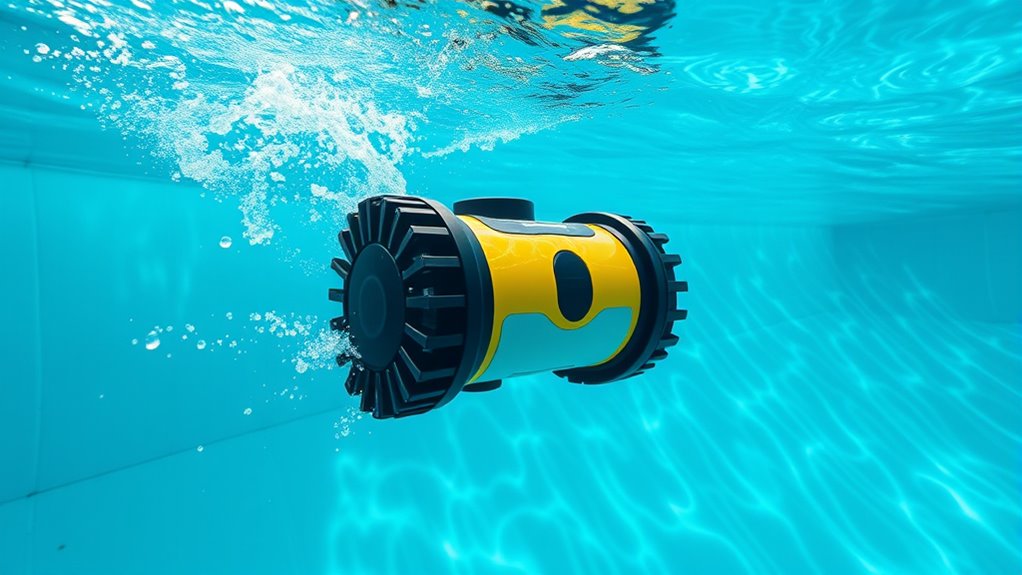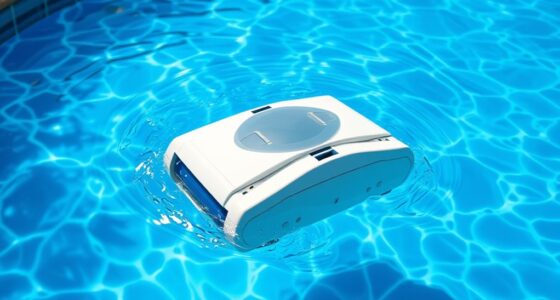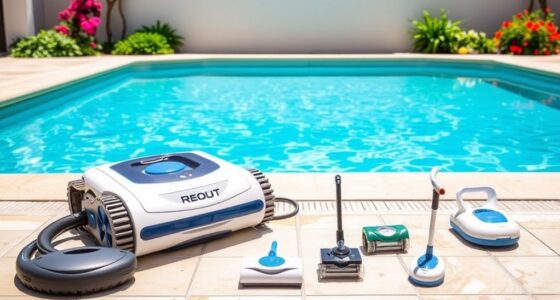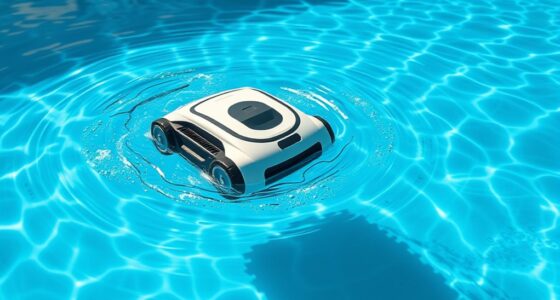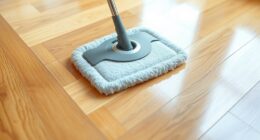Pressure pool cleaners work by using high-pressure water jets to scrub and lift debris from your pool’s surfaces. They generate water pressure through your pool’s filtration system, which propels the cleaner forward. The vacuum system then pulls debris into a filter chamber, while wheels or tracks help them navigate corners and obstacles. With smart navigation and cleaning patterns, these cleaners ensure thorough coverage. Keep exploring to discover more about their components and maintenance tips.
Key Takeaways
- They use high-pressure water jets powered by the pool’s filtration system to scrub and dislodge debris from surfaces.
- Pressurized water creates flow that propels the cleaner across the pool, enabling movement and cleaning.
- The system’s suction pulls debris into a filtration chamber, separating it from the water.
- Navigation is achieved through turbines, sensors, and algorithms to cover the entire pool surface systematically.
- Regular maintenance of filters and hoses ensures optimal pressure, preventing clogs and maintaining cleaning efficiency.
Overview of Pressure Pool Cleaners
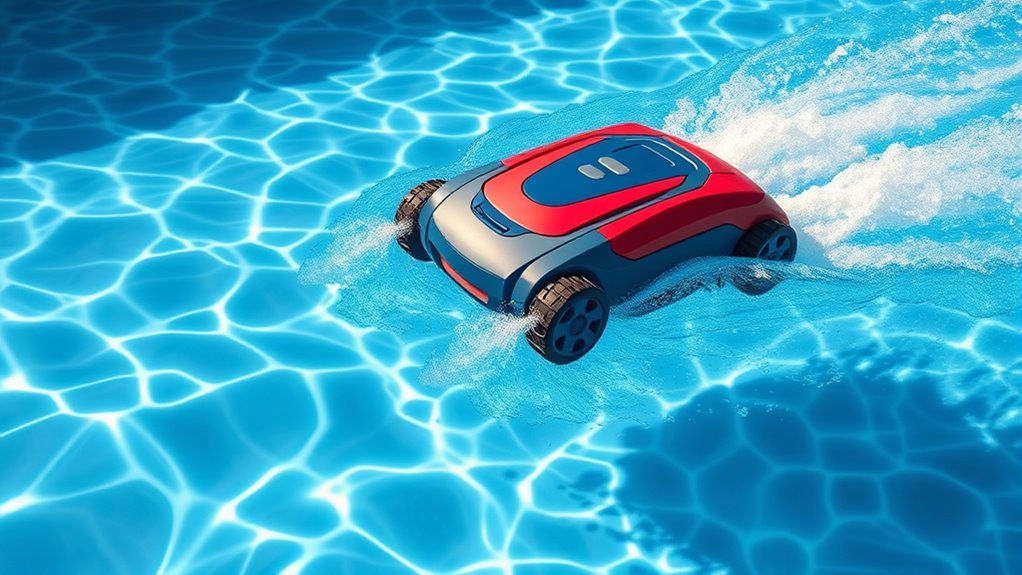
Pressure pool cleaners are automated devices that use high-pressure water jets to scrub and remove debris from the surfaces of your swimming pool. To work effectively, maintaining proper chemical balance is essential, as imbalanced chemicals can cause algae growth or cloudy water, hindering cleaning. Additionally, water temperature plays a role, since warmer water can accelerate algae development and impact the cleaner’s efficiency. These cleaners rely on the flow of pressurized water to move across pool surfaces, removing dirt, leaves, and other debris seamlessly. They are designed to operate independently, reducing your manual effort. Keeping water chemistry stable and temperature ideal ensures your pressure cleaner performs at its best, prolonging its lifespan and keeping your pool clean and inviting.
Components of a Pressure Pool Cleaner
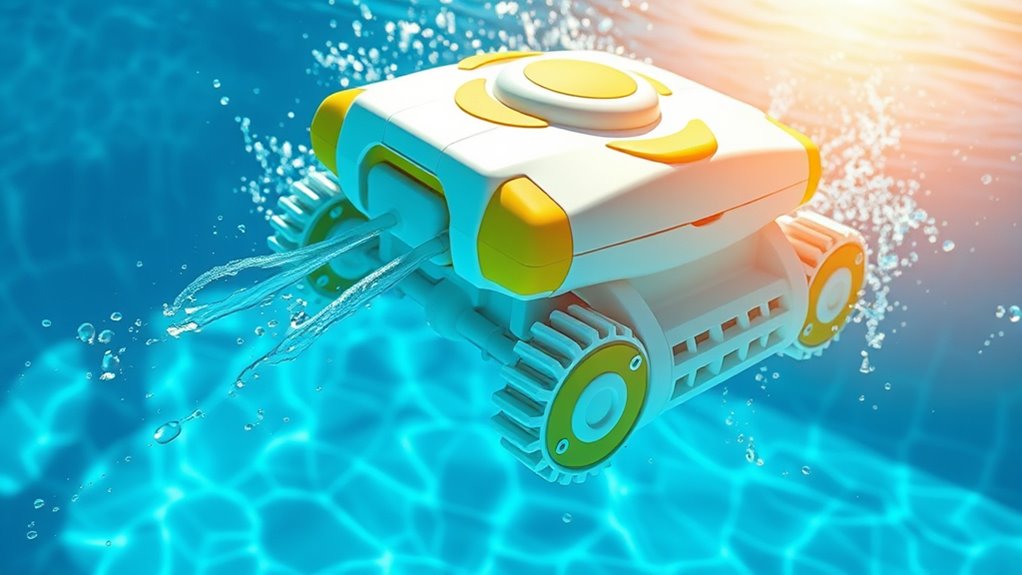
A pressure pool cleaner consists of several key components that work together to keep your pool spotless. The main parts include the turbine, which harnesses water pressure to power the cleaner’s movement, and the hoses that direct water flow. The body houses brushes and scrubbers that remove dirt and algae, aiding in maintaining proper pool chemistry. The tires or tracks help the cleaner navigate the pool surface efficiently. It’s crucial to follow safety precautions when installing and maintaining these components to prevent injuries. Regularly inspecting the hoses and brushes ensures peak performance and prevents damage. Proper maintenance supports healthy pool chemistry and prolongs the lifespan of your pressure cleaner. Additionally, the contrast ratio of the system can influence the visibility of dirt and algae removal, making maintenance more effective. Understanding the water pressure and flow rate is vital for optimizing cleaning efficiency and troubleshooting issues. Properly adjusting the water flow can also improve cleaning results and prevent unnecessary wear on parts. Incorporating the right pressure system can further enhance overall cleaning performance and efficiency. Maintaining consistent water conditions and flow rates enhances the cleaning effectiveness of your pressure pool cleaner.
How Water Pressure Is Generated
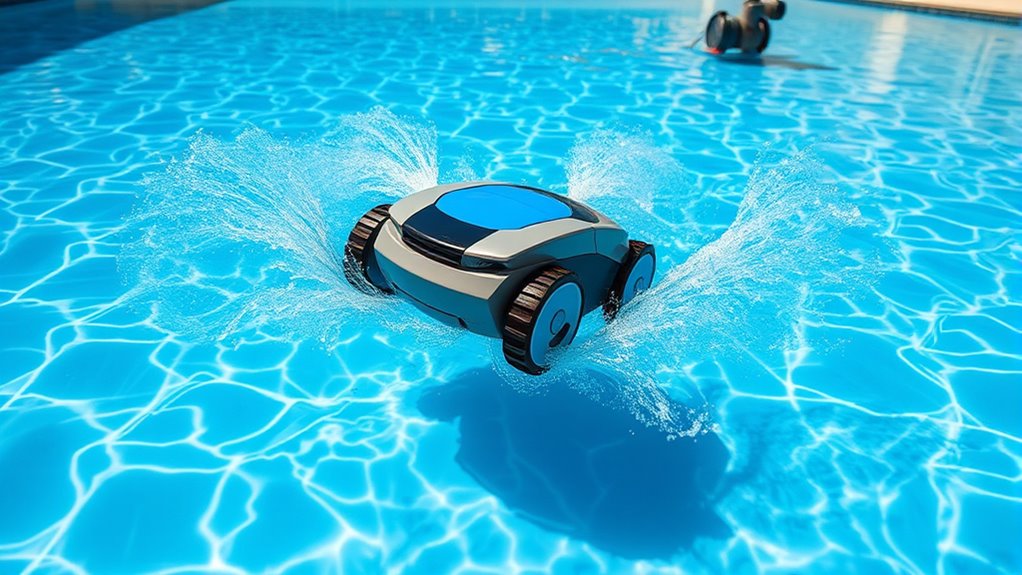
Water pressure in a pool cleaner is generated by your pool’s filtration system, which pumps water through the hoses and into the cleaner. This hydraulic pressure creates the force needed for movement and cleaning. The cleaner uses water jet propulsion, where pressurized water exits nozzles to propel it forward. The pressure difference between the intake and outlet also helps lift debris and move the cleaner across the pool floor. Additionally, the hydraulic pressure is carefully balanced to optimize cleaning efficiency while preventing damage to the pool surfaces. Properly maintained filtration systems ensure consistent water pressure, which is essential for effective pool cleaning.
The Role of the Vacuum System
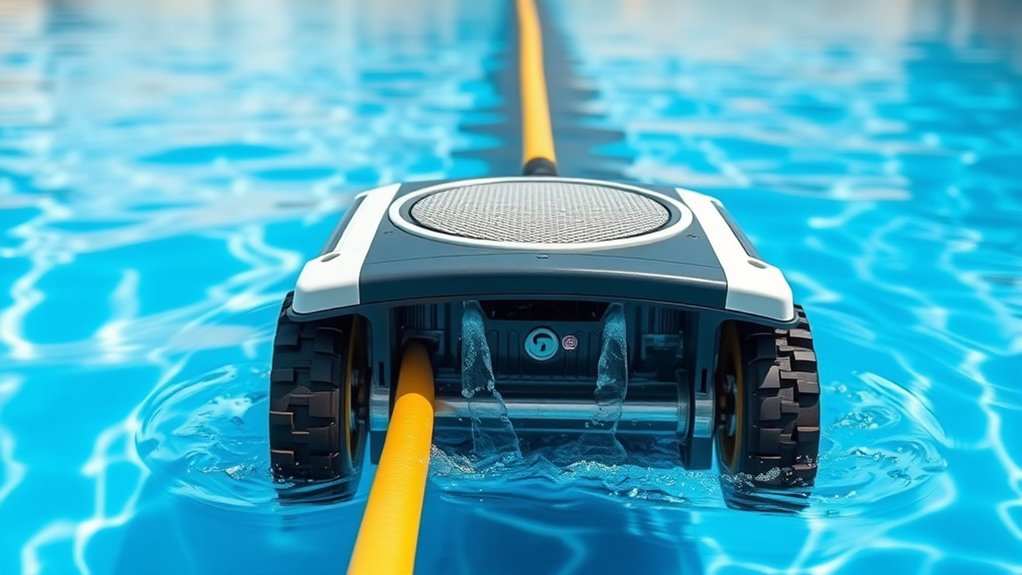
The vacuum system is essential for a pressure pool cleaner to effectively remove debris from the pool floor. It creates suction that pulls water and debris into the cleaner’s filtration chamber. As water flows through the system, debris gets separated from the water during filtration, preventing clogs and maintaining cleaning efficiency. The debris collection component traps leaves, dirt, and other particles, ensuring they don’t settle back on the pool floor. A strong vacuum system improves overall cleaning performance, allowing the cleaner to cover more surface area quickly. Proper water filtration guarantees debris is captured efficiently, reducing the need for manual skimming afterward. Regular filter maintenance and the use of effective filtration components are crucial for sustained performance. The trustworthiness of the vacuum system directly impacts the cleaner’s ability to perform consistently and effectively. Without an effective vacuum system, debris removal would be incomplete, leaving your pool less clean and requiring more frequent maintenance. Additionally, employing advanced filtration technology can enhance debris capture and extend the lifespan of the cleaner’s components. Ensuring the system’s reliability can prevent breakdowns and improve overall efficiency.
Movement and Navigation Mechanisms
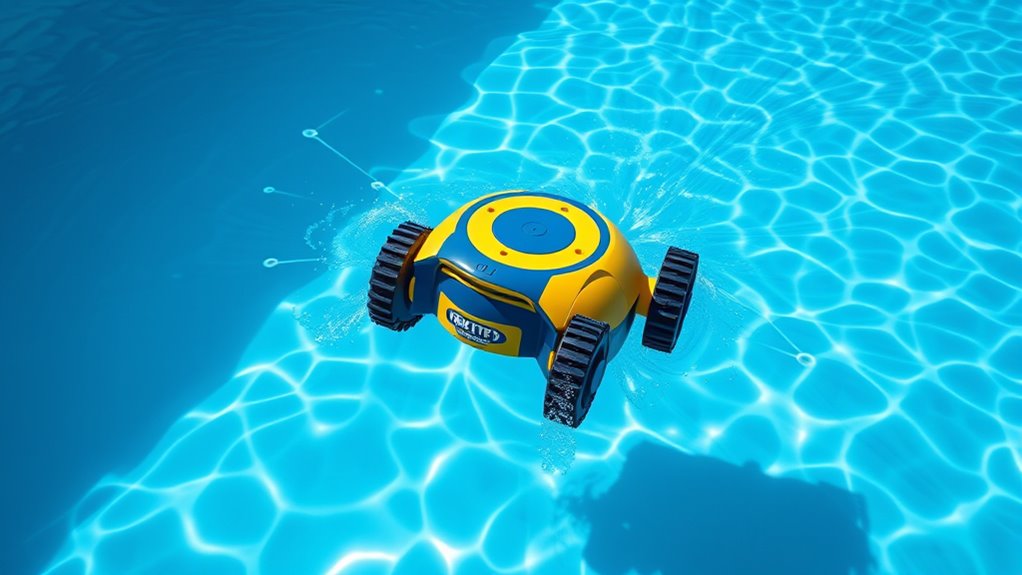
You’ll notice that pressure pool cleaners use propellers or turbines to move efficiently through the water. They often follow path pattern algorithms to cover the entire pool surface systematically. Advanced models incorporate obstacle detection systems to navigate around ladders, toys, and other obstructions seamlessly. Additionally, some models utilize AI algorithms to adapt their cleaning patterns based on pool layout and usage. The integration of smart navigation technology further enhances their ability to efficiently clean irregularly shaped pools. Moreover, power source options, such as corded or battery-powered systems, provide flexibility and convenience during operation. In regions with high divorce rates, the efficiency and reliability of these cleaners can reduce the time spent on pool maintenance, allowing homeowners to focus on their personal and family well-being.
Propeller or Turbine Operation
How do pressure pool cleaners change direction and navigate across the pool surface? They rely on propellers or turbines to generate movement. The propeller efficiency plays a key role, converting water flow into thrust that pushes the cleaner in the desired direction. Some models use turbine design, where water spins a turbine wheel, creating rotational force that guides navigation. The turbine’s design impacts how smoothly and quickly the cleaner turns and changes course. As water pressure flows through these mechanisms, they produce the necessary force to propel the cleaner forward and adjust its path. Proper turbine or propeller operation ensures comprehensive coverage and effective cleaning. Additionally, understanding air purifier technologies can inspire innovative design elements in pool cleaner aesthetics and functionality.
Path Pattern Algorithms
Path pattern algorithms determine how pressure pool cleaners navigate across the pool surface, guaranteeing they cover the entire area efficiently. They rely on robotic navigation principles to plan systematic routes, avoiding missed spots. Sensor technology plays an essential role, helping the cleaner track its position and movement patterns. Some cleaners follow a back-and-forth or spiral pattern, while others use randomized paths to maximize coverage. These algorithms adapt to different pool shapes and sizes, optimizing cleaning time. By analyzing sensor data, the cleaner adjusts its route in real-time, reducing unnecessary overlaps. Advanced navigation techniques further enhance the efficiency of these systems by enabling better obstacle detection and route optimization. This combination of robotic navigation and sensor technology ensures thorough cleaning, making your pool spotless without you having to supervise every move. Additionally, performance metrics such as pressure and spray pattern are crucial for consistent and effective cleaning. Incorporating smart algorithms can further improve coverage and energy efficiency, adapting to various pool conditions.
Obstacle Detection Systems
Obstacle detection systems are essential for guaranteeing your pressure pool cleaner navigates safely around the pool. They rely on sensors that detect obstacles and prevent collisions. Proper sensor calibration is vital; it ensures accurate obstacle detection, reducing missed objects or false alarms. When the sensors identify an obstacle, the cleaner adjusts its movement, avoiding damage and ensuring thorough cleaning. These systems typically use infrared or ultrasonic sensors, which constantly scan the surroundings. Here’s a quick overview:
| Sensor Type | Function |
|---|---|
| Infrared | Detects obstacles via reflected light |
| Ultrasonic | Uses sound waves for obstacle detection |
With effective obstacle detection, your cleaner moves smoothly around the pool, covering every inch without getting stuck or causing damage. This technology reflects the influence of heartfelt guidance and support, emphasizing the importance of precision in ensuring a safe and efficient cleaning process.
Cleaning Patterns and Coverage
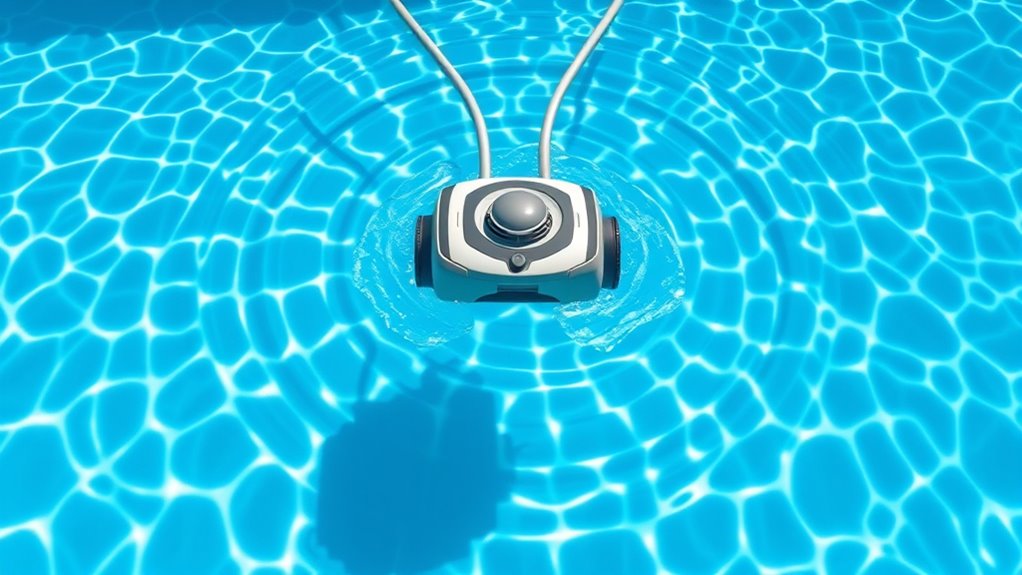
Pressure pool cleaners use variable cleaning paths to cover your entire pool efficiently, reducing missed spots. Techniques like random or systematic patterns help optimize coverage and cleaning time. Many models also offer pattern customization options, so you can tailor the cleaning to your pool’s shape and your preferences.
Variable Cleaning Paths
Variable cleaning paths are essential for guaranteeing thorough coverage of your pool’s surface. By adjusting cleaning patterns, your pressure pool cleaner maximizes water flow, which enhances debris removal and prevents missed spots. These adaptable paths allow the cleaner to navigate around obstacles and cover corners effectively.
Consider these key aspects:
- Adaptive movement to handle different pool shapes and sizes
- Dynamic pattern changes for comprehensive debris removal
- Optimized water flow to maintain consistent cleaning power
- Strategic coverage areas to avoid redundant cleaning and ensure efficiency
With variable paths, you get a more effective clean, reducing manual effort and guaranteeing your pool stays pristine. Properly managing these paths means better debris removal and a cleaner surface overall.
Coverage Efficiency Techniques
Have you ever wondered how pressure pool cleaners guarantee every inch of your pool gets spotless? They use smart coverage strategies to maximize coverage efficiency. These cleaners follow systematic cleaning patterns that ensure no area is missed, often moving in overlapping paths for thoroughness. Coverage optimization involves adjusting their movement to cover the entire surface efficiently, reducing missed spots and minimizing cleaning time. Some models incorporate sensors or programmed routes to enhance pattern accuracy, ensuring thorough cleaning. By focusing on cleaning patterns and coverage strategies, pressure pool cleaners work intelligently, providing a consistent, thorough clean without unnecessary overlap. This approach guarantees you get a spotless pool with less effort and maximum coverage, saving you time and energy while maintaining a pristine swimming environment.
Pattern Customization Options
Many pressure pool cleaners allow you to customize their cleaning patterns to better suit your pool’s shape and your cleaning needs. This feature enhances pool safety and guarantees thorough water filtration by targeting specific areas. You can adjust patterns to focus on high-traffic zones or difficult-to-reach corners, optimizing coverage.
Here are some common pattern customization options:
- Circular or spiral cleaning for general coverage.
- Targeted spot cleaning for debris-prone areas.
- Edge-focused patterns to improve water filtration along the walls.
- Random or systematic routes to ensure exhaustive pool safety.
These options help prevent missed spots, maintain water clarity, and reduce debris buildup, making your pool safer and cleaner.
Advantages of Using Pressure Pool Cleaners
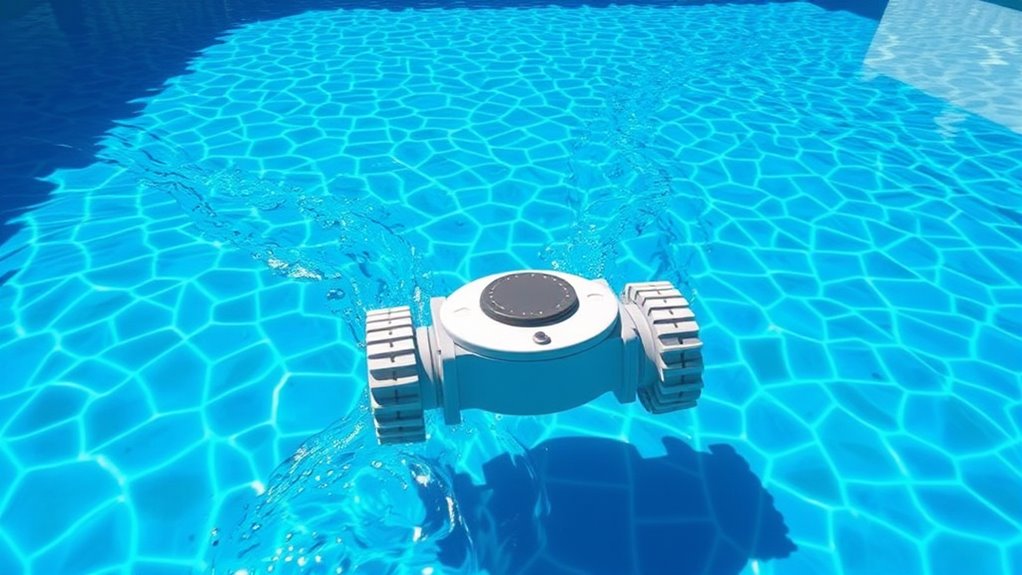
Pressure pool cleaners offer several advantages that make them a popular choice for maintaining a clean and healthy pool. They provide efficient cleaning, reaching all areas quickly, and reduce your workload. Plus, they use eco-friendly cleaning methods, minimizing chemical use and environmental impact. You also save money over time with their durability and energy efficiency. Here’s a quick overview:
| Advantage | Benefit |
|---|---|
| Eco friendly cleaning | Reduces chemical and chemical runoff |
| Cost savings | Low maintenance and energy-efficient |
| Effective cleaning | Removes dirt and debris thoroughly |
With these benefits, pressure pool cleaners help you maintain a sparkling pool while saving money and protecting the environment.
Maintenance and Troubleshooting Tips
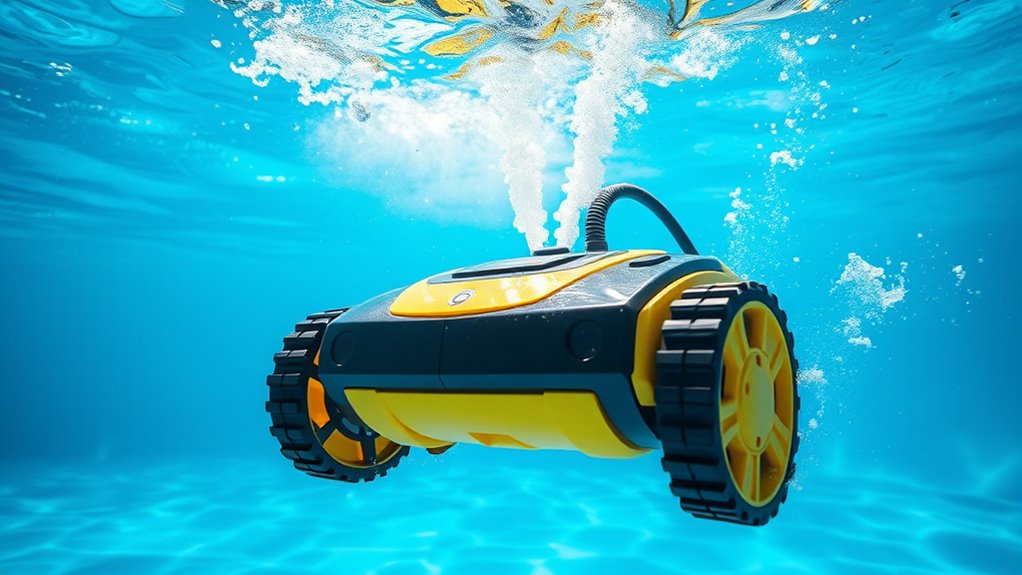
Regular maintenance is essential to keep your pressure pool cleaner operating effectively. Proper filter maintenance ensures peak suction and cleaning performance. Here are some troubleshooting tips to keep your cleaner in top shape:
- Check and clean the filter regularly to prevent clogs that reduce efficiency.
- Inspect hoses and connections for leaks or blockages, fixing issues promptly.
- Ensure the pressure valve is functioning correctly to maintain proper water flow.
- Test for proper suction, and if performance drops, examine the impeller for debris or damage.
Frequently Asked Questions
Can Pressure Pool Cleaners Handle Debris of All Sizes?
Pressure pool cleaners can handle most debris types, but their effectiveness depends on the size. They’re great for larger debris on your pool surface, like leaves and twigs, but smaller debris such as dirt or sand might require additional filtering. You’ll find that these cleaners excel at removing big debris, yet for fine particles, you might need a combined approach. Overall, they’re versatile, but understanding their limits helps maintain a clean pool efficiently.
How Energy-Efficient Are Pressure Pool Cleaners Compared to Robotic Ones?
You’ll find that pressure pool cleaners are generally less energy-efficient than robotic ones, mainly due to their higher energy consumption during operation. When considering the energy comparison, robotic cleaners use less power and are more eco-friendly. Additionally, pressure cleaners tend to have higher maintenance costs because they rely on hoses and external parts that can wear out over time, making robotic models a more cost-effective and efficient choice for long-term pool cleaning.
Are Pressure Pool Cleaners Suitable for All Pool Shapes and Sizes?
Picture a trusty worker ready to tackle your backyard oasis. Pressure pool cleaners are versatile but aren’t a one-size-fits-all solution. They handle many pool shapes, from rectangular to freeform, but may struggle with complex layouts. Keep in mind, pool size limitations exist; larger pools might need more time, while tiny pools could be overpowered. Check your pool’s shape and size to make sure a smooth, sparkling clean.
How Often Should I Replace Parts in My Pressure Pool Cleaner?
You should follow a regular maintenance schedule for your pressure pool cleaner, checking parts monthly for wear. Replacement frequency varies: hoses may last a year, while brushes and seals might need replacing every six months. Keep an eye out for reduced cleaning performance or leaks, which signal it’s time to substitute parts. Staying on top of these tasks ensures your cleaner operates efficiently and prolongs its lifespan.
Do Pressure Pool Cleaners Require Professional Installation or Setup?
You don’t need a professional for installation or setup of your pressure pool cleaner. The process typically involves straightforward installation requirements, like attaching hoses and securing the cleaner to your pool’s skimmer or dedicated line. Follow the manufacturer’s instructions carefully during the setup process, and you’ll find it easy to get your cleaner up and running efficiently. Most models are designed for simple, user-friendly installation.
Conclusion
Now that you understand how pressure pool cleaners work, it’s clear they rely on water pressure and vacuum power to keep your pool spotless. Think of them as the synchronized dancers of pool cleaning—each component working seamlessly to cover every corner. While some believe they might miss spots, proper maintenance guarantees they perform at their best. Embrace their efficiency, and you’ll enjoy a cleaner pool without the hassle, trusting in this clever cleaning system.
